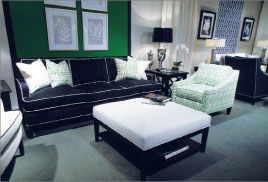
Libby Langdon's introductions for Braxton Culler feature dramatic color mixes and transitional styles.HIGH POINT - The remodeled Braxton Culler showroom at 310 S. Elm St. is a study in both style and substance at this fall's High Point Market.
In one sense, the latest renovations to the former textile factory are the ideal industrial chic backdrop for the company's upholstery and casual introductions. In another, Braxton Culler's most recent expenditures on the property represent an important facet of High Point's economic vitality - the ongoing investment in the city's infrastructure from furniture manufacturers.
A recent study conducted by the Center on Globalization, Governance & Competitiveness at Duke University documented the impact of the market on the local and state economies. According to the study, High Point Market contributes more than $5.4 billion in regional economic impact, more than 37,000 in jobs and $198 million in North Carolina local and state taxes and fees.
For many people, the correlation to the economic impact is found in the furniture sales that accompany the biannual market. However, several recent renovation announcements underscore the year-round influence that the furniture industry has on High Point.
"I invested in High Point in 1986 when I bought this building," said Braxton Culler, president of the company. "Of course, the initial investment was very primary, but over the years, we have continued to do things to upgrade the building and renovate. Really, anyone who has a showroom at the market has made an investment in High Point."
Culler added that he thinks having the main market buildings "settled" adds stability for the entire city of High Point.
"People are satisfied that High Point Market is here to stay now," he said. "I think High Point has done very well considering the economic climate of the past few years, but people are investing in High Point again, and that's the best thing that can happen to strengthen the position of the market and stabilize the marketplace."
When he purchased the former factory 27 years ago, Culler couldn't have envisioned that the open ductwork, exposed brick and factory floors would make a style statement decades later.
But as the urban population continues to grow and abandoned factories are repurposed for city residences, the Braxton Culler showroom allows dealers to see more than 60 new market introductions in an environment similar to many of their urban customers' homes.
"It certainly allows us to showcase our products more appropriately," Culler said.
In addition to a color-soaked, dramatic upholstery introduction by Libby Langdon for Braxton Culler, the company is also bringing new wicker, rattan and casual product to the market.
"The ability to weave outdoor fabric that looks like indoor residential has changed the industry," Culler said. "Before, the textiles looked like a raincoat. But there has been an evolution in terms of the materials utilized for upholstery. It's almost bulletproof and the design element is almost unlimited. A big part of what we do in furniture is fashion, and we now have more choices, colors and styles than ever before."





